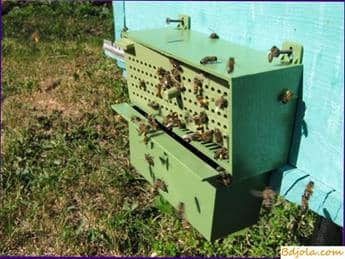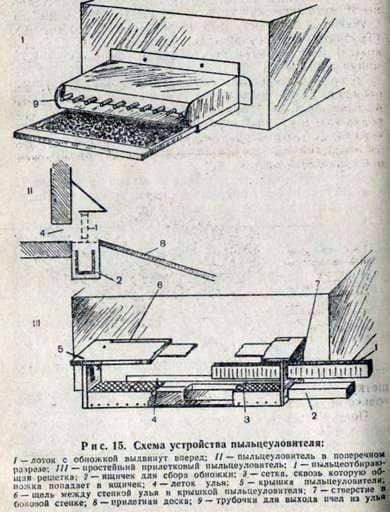Schemes of pollen catchers

Receiving pollen from plants or pergs from honeycombs is a very laborious process. You can get the pollen already collected by bees, by selecting their updates from the tap when returning to the hive. Practical implementation of this selection of updates was possible only after careful observation of the behavior of the bees, which were forced to pass into the hive through various holes in the plate covering the duct. It was found that the small beetles carried to the beehive in a beehive when passing through a round hole of any size sufficient for the passage of the bee. Large beetles lose their losses when passing through holes that are close in size to 5×5 mm. On this basis, devices were proposed, called pollen catchers.
The pollen collector, made by the employees of the Institute of Apiculture, which allows to select 40-50% of the insertable update, consists of a pollen grating, which can be made of wire with a thickness of 0.3 mm. To do this, in a small wooden block of a 35 cm long tree, 4 cm in width and exactly 0.5 cm thick, 2 small windows with a length of 13 cm and a width of 2.2 cm are cut out. In all four ribs, the plaques make markings for the wire at a distance of 4.8 mm and a knife or a razor for her shallow grooves. Then they wind the whole board with wire and carefully tighten it. On one of the fins the planks of the recess are made obliquely to transfer the wire from one row to the next, as a result of the holes on one side of the wires will be opposite the holes on the opposite side of the plate. The transverse wires are then stretched in the same way,
Bees pass through the holes of such a lattice without difficulty. Pushing the head and breast into the opening of the first grid, the bee on its way meets the second grate, which grasps the front legs, and stretches the body forward. Both hind legs are pressed against the abdomen, and the lumps of pollen are cut off
The device of the pollen collector is shown in Fig. 15.

It consists of two side plates, a box for pollen covered with a grid, a pollen-picking grid and a lid. In the side wall of the pollen collector there are 2 openings: the large one – at the bottom (6X4 cm) – for setting the box (2), into which the inserts get, and the smaller one at the top (2X4 cm) for the pollen grating (1). The box of a pollen trap 30 cm long and 6 cm high is covered from above with a wire mesh (3), along which the bees go to the hatch (4) of their hive.
The bee arriving at the beehive sits on the board (8), along which it gets on the metal net (3), which closes the pollen box. Then, the bee passes through the double pollen selection grid (1) and enters the frame of the nest.
The bee coming out of the hive on the bottom, meeting the grate, turns to the right or left, goes along the grate and reaches the hole. In the side wall (7), through which it comes out. The bee that emerges along the upper wall of the hive falls into a gap (6) 8-10 mm wide, which remains between the wall of the hive and the lid of the pollen trap. Consequently, the pollen collector allows the bees to escape from the hive, bypassing the grate.
The dust catcher is hung on the front wall of the hive so that it covers the entire chute. The pollen-picking grid is removed so that within 2-3 days the bees are accustomed to fly through the pollen collector. Then in the morning hours, when the bees carry a large number of renovations in the beehive, the pollen-selecting grid is inserted through the side window. Bees, accustomed to fly through the pollen collector, go into it and pass through the grate, almost without delaying at the tap.
Described pollen catcher allows you to select from bees not only large, but also average in size updates. However, we can limit ourselves to selecting only the large updates that the bee loses when passing through a grate with round holes of 5 mm in diameter made in a plastic plate.
Figure 15, I shows a pollen trap that has 10 metal tubes 8-10 mm in diameter in the front wall, at the floor level of the hive, protruding 20 mm behind the wall of the pollen catcher (9). These ducts serve to exit the bees from the hive, bypassing the grate.
In the practice of large apiaries, which extract pollen for sale, so-called bottom pollen catchers have found application. In such pollen collectors, the bees freely enter the hive through the flock to the bottom of the hive, but in order to reach the honeycomb of the nest, they must pass through one of the holes of the pollen grating located horizontally.

The dust collector is provided with a blocking valve; when it is raised, the bees go into the nest, bypassing the rash, when it is lowered, the bees can enter the nest only through the pollen-collecting grid.
It is necessary to lift the valve and start the bees through the pollen collector only on days and hours, when bees carry a lot of updates. During the rest of the time, as well as during a significant nectar feeding, the pollen collector must be disconnected, which is achieved by appropriate movement of the obstruction valve.
The update is obtained during 1-2 spring months, when the pollen plants bloom and the bee pollen is selected quickly for the selection of a portion of the pollen. On good warm, quiet days from strong families, you can get 100-120 grams of updates per day, and for a season – 2-3 kg of updates without deterioration of brood brood and honey.
Practice has shown that frequent switching on and off of the pollen grating makes it difficult for years of bees, therefore, during the entire period of intensive introduction of pollen, it is necessary to have the included pollen collectors. Drones and uterus can freely leave the hive, but they can not enter it through the included pollen gratings. Therefore, it is not necessary to receive the update from families allocated for drones or with barren uteri. When transporting bees, mounted pollen collectors are removed and re-hung in a new place.
Pollen storage (renovation). Renewal is a perishable product, it is necessary to take it out of the hives daily. There are two ways to prepare an update for storage. At the first method the collected update is immediately stirred with honey in the proportion: 1 kg of mature honey 1 kg freshly picked up. The mixture is ground to a homogeneous mass and piled in wooden barrels or glass jars. The surface of the folded mass should be poured a thin layer of thick honey or covered with sealed lids.
You can mix the refresh with sugar, taking it 2 kg per 1 kg of pollen.
In the second method, the update is stored in the dried state. To do this, freshly harvested refreshment is spread on sheets of plywood with a layer of 1.5-2 cm and placed in a dry place in a draft under a canopy, but always in the shade. The refreshment is periodically stirred until the water content in it reaches 12-13%. The readiness of the pollen can be defined as follows: from a height of 20-25 cm, a small piece of vine is poured out on the plywood; if this pollen will produce a sonorous, like a metallic sound, and the lumps of pollen are crushed with difficulty, then the pollen is ready for storage. With this drying, the color of the updates is preserved. Update, brought to an air-dry state, should be stored in hermetically sealed dishes, best packed in polyethylene bags of a certain volume (3, 5, 10 kg) | the ends of which are closed by hot welding.
Store the update at a temperature of 0-15ss in a dry room without sharp foreign odors. Freezing greatly reduces the quality of pollen.
Pollen and its aqueous extract are successfully used in the treatment of encephalitis, prostatitis, hepatitis, bronchitis and sclerosis. Now that a method has been developed for the mass production of pollen, the problem of using it in beekeeping as well as in the food (vitamin, confectionery) industry can be quite solvable.
Schemes of pollen catchers
